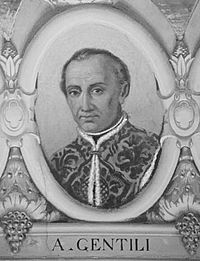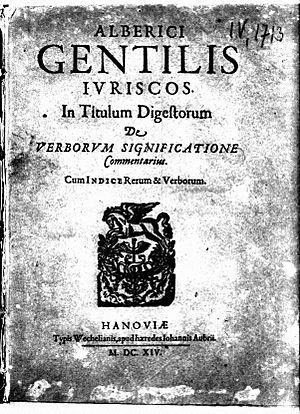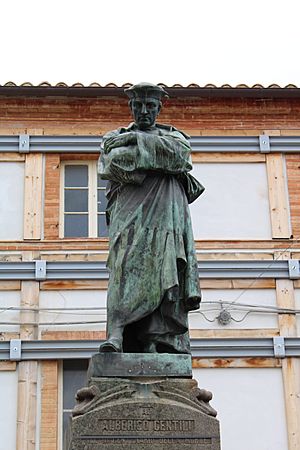Alberico Gentili facts for kids
Quick facts for kids
Alberico Gentili
|
|
|---|---|

Engraved portrait of Gentili
|
|
| Regius Professor of Civil Law | |
| In office 1587–1608 (his death) |
|
| Monarch | Elizabeth I |
| Preceded by | William Mowse |
| Succeeded by | John Budden |
| Personal details | |
| Born | 14 January 1552 San Ginesio, Macerata, Italy |
| Died | 19 June 1608 (aged 56) London, England |
| Spouse | Hester de Peigne |
| Relations | Scipione Gentili (brother) |
| Children | Roberto Gentili |
| Parents | Dr Matteo Gentili Lucrezia Petrelli |
| Alma mater | University of Perugia |
| Known for | Substantial contributions to the theory of international law, human rights and war; First writer on public international law; Regius Professor |
Alberico Gentili (born January 14, 1552 – died June 19, 1608) was an important Italian-English lawyer and teacher. He taught Queen Elizabeth I of England and worked for the Spanish Embassy in London. For 21 years, he was a special professor of law at Oxford University. Many people call him the "Father of International Law" because he helped create this field. He was also the first person not from England to become a Regius Professor at Oxford.
Gentili wrote several books that are very important for understanding international law. These books also covered topics like religion and literature.
Contents
Alberico Gentili's Early Life
Alberico Gentili was born into a noble family in San Ginesio, a town in Italy. His father, Matteo Gentili, was a famous doctor. Matteo taught young Alberico Latin and Greek.
Alberico earned a special degree in law at the University of Perugia when he was just 20 years old.
Gentili's Career and Challenges
After finishing his studies, Gentili was chosen to be the chief judge of Ascoli Piceno. However, he soon returned to his hometown and took on other important jobs.
Alberico, his father, and his brother Scipione Gentili were part of a group that discussed ideas different from the Roman church. The Inquisition, a religious court, started looking for people with these beliefs. Because they were Protestants, the Gentili family had to leave Italy.
They first went to Ljubljana, which is now in Slovenia. From there, Alberico traveled to German university towns like Tübingen and Heidelberg. His father, Matteo, became the chief doctor for the area of Carniola. However, the church leaders soon forced them to leave Austrian lands too.
In early 1580, Alberico went to England. He was already known for his legal skills and had offers to teach at universities in Germany. He arrived in London in August. He met Giovanni Battista Castiglione, who taught Italian to Queen Elizabeth I. Gentili also became friends with Tobias Matthew, who later became the Archbishop of York.
On January 14, 1581, Gentili was officially recognized as a Doctor of Civil Law (D.C.L.) at Oxford. This allowed him to teach law. He first taught at St John's College, Oxford. Later, Robert Dudley, the head of Oxford University, appointed Gentili as the Regius Professor of Civil Law at Oxford.
In 1584, the English government asked for Gentili's advice. They had found out that Bernardino de Mendoza, the Spanish ambassador, was planning against Queen Elizabeth. Gentili suggested what to do, and Mendoza was then sent out of England. Gentili wrote a book about this topic called De legationibus libri tres.
Gentili kept his professorship until he died. However, after 1590, he spent more time working as a lawyer in London. He worked in the High Court of Admiralty, which used civil law instead of English common law. In 1600, Gentili became a member of Gray's Inn, a group of lawyers. He died in London and was buried in the Church of St Helen Bishopsgate.
In 1589, he married Hester de Peigne, a French Huguenot. His oldest son, Robert Gentilis, graduated from Oxford University at age 12. He became a Fellow at All Souls College, Oxford at 17, thanks to his father's help.
Alberico Gentili's Important Books
In 1582, Gentili published De Juris Interpretibus Dialogi Sex. In this book, Gentili strongly supported the "bartolist" way of studying law. He disagreed with French lawyers who used language studies to understand Roman law.
Gentili's first book about international law was De Legationibus Libri Tres, published in 1585. This book discussed the rules for ambassadors and how countries should treat them.
Between 1588 and 1589, Gentili published three small books called De Jure Belli Commentationes Tres. A bigger version, De Jure Belli Libri Tres, came out in 1598. This is seen as his most important work and a classic book on public international law. People praise it for being modern and for using legal ideas well. It also showed how international law was actually practiced at the time.
Gentili published De armis Romanis in two parts in 1590 and 1599. This work has been studied more recently by scholars.
After Alberico Gentili died, his brother Scipione published a collection of notes. These notes were about cases Alberico had worked on for the Spanish embassy. The book is called Hispanicae Advocationis Libri Duo and was published in 1613.
Gentili's Lasting Impact
For a while, Gentili's fame as an international lawyer was overshadowed. This happened after Hugo Grotius published his very important book, De Jure Belli ac Pacis, in 1625. Even though Grotius learned a lot from Gentili's writings, Grotius's book became more famous.
It wasn't until the 1800s that people became interested in Gentili again. Sir Thomas Erskine Holland, a professor at Oxford, helped bring attention back to Gentili's work. In 1874, he gave a lecture about Gentili. Recent studies show that Gentili's ideas on the laws of war became very important in the late 1800s. A group of international lawyers used his writings to help create the modern laws of war.
Since then, many books and articles have been written about Gentili and his work. In his hometown, a monument was built to honor him.
Statue of Alberico Gentili
The statue of Alberico Gentili was made by Giuseppe Guastalla in 1908. It was built to mark 300 years since Gentili's death. This statue played a special role during World War II. It was important when the Allies freed San Ginesio, Gentili's hometown.
A plaque added in 2009 tells a short story:
Alberico Gentili, who died in London in 1608, was the first to advocate humane treatment for Prisoners of War. After the Italian Armistice in September 1943, thousands of P.O.W.s escaped from their prison camps. The country people in and around San Ginesio and all over German-occupied Italy gave them food and shelter, in spite of the danger in so doing.
Their bravery, compassion and self-sacrifice will never be forgotten by the Allied Prisoners of War, nor by their descendants.
Monte San Martino Trust - London. 2009
See also
 In Spanish: Alberico Gentili para niños
In Spanish: Alberico Gentili para niños



